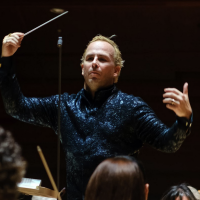Join us on Sunday, Aug. 10 at 1 p.m. on WRTI 90.1 and Monday, Aug. 11 at 7 p.m. on WRTI HD-2 as The Philadelphia Orchestra in Concert brings you a single work: Mahler’s massive Symphony No. 3 in D Minor, with mezzo-soprano Joyce DiDonato and three local choirs: the Philadelphia Boys’ and Girls’ Choirs, as well as the women of the Philadelphia Symphonic Choir. Yannick Nézet-Séguin conducts.
Gustav Mahler started his Third Symphony with inspiration from nature. This work, he wrote, would encompass “all the stages of evolution, ascending step by step. It begins with lifeless Nature and rises to God’s love!” The composer initially assigned titles to the six movements of this work, and though he ultimately withdrew them, they offer important clues to the emotional architecture of the symphony. The first movement was initially called “The Awakening of Pan” — referring to an ancient god of nature. It begins with an evocation of “the original chaos,” says Yannick, that eventually becomes a march. This “starts very softly and becomes huge. It becomes the world. It becomes everything that's forming.”

The second movement was titled “What the Flowers in the Meadow Tell Me,” followed by “What the Animals in the Forest Tell Me” — in which, says Yannick, there’s a touch of humor: “We can hear the donkey right away at the beginning.” It’s not until the fourth movement, originally titled “What Mankind Tells Me,” that mezzo-soprano soloist Joyce DiDonato is heard. She solemnly intones a poem by Friedrich Nietzsche that begins, “Oh man, take heed!” This somber mood is then dispelled by a joyous choral movement. Its text is a folk poem, depicting angels singing in heaven. They are represented by a chorus of women and children, imitating bells. That movement, of course, at first had the title “What the Angels Tell Me,” and though the mezzo-soprano breaks in with a desperate plea to God for mercy, the angels answer with exuberant reassurance.
The consoling and ultimately majestic finale was, in Mahler’s initial inspiration, “What Love Tells Me.” Says Yannick: “Mahler, the poet, is looking at all this and reflecting how it affects him. And therefore, how it affects all of us. I can't conduct this music without having tears in my eyes to this day.”
The Third Symphony is monumental both in length — more than an hour and a half — and in numbers. In addition to the choirs and the mezzo-soprano, Mahler calls for a truly huge orchestra, and he keeps everyone busy. There are four flutes, all of whom double on piccolo; four oboes, one doubling English horn; five clarinets in three registers; no fewer than eight horns; four trumpets plus offstage posthorn; four trombones and tuba; timpani; and a massive battery of percussion, in addition to the full complement of strings.
PROGRAM:
Mahler: Symphony No. 3 in D Minor
The Philadelphia Orchestra
The Philadelphia Girls’ Choir
The Philadelphia Boys’ Choir
The Philadelphia Symphonic Choir
Yannick Nézet-Séguin, conductor
Joyce DiDonato, mezzo-soprano
WRTI PRODUCTION TEAM:
Melinda Whiting: Host
Alex Ariff: Senior Producer
Joseph Patti: Broadcast Engineer
Listen to The Philadelphia Orchestra in Concert broadcasts every Sunday at 1 p.m. on WRTI 90.1, streaming at WRTI.org, on the WRTI mobile app, and on your smart speaker. Listen again on Mondays at 7 p.m. on WRTI HD-2. Listen for up to two weeks after broadcast on WRTI Replay.


